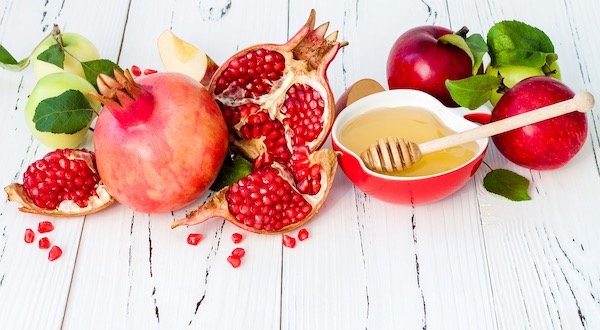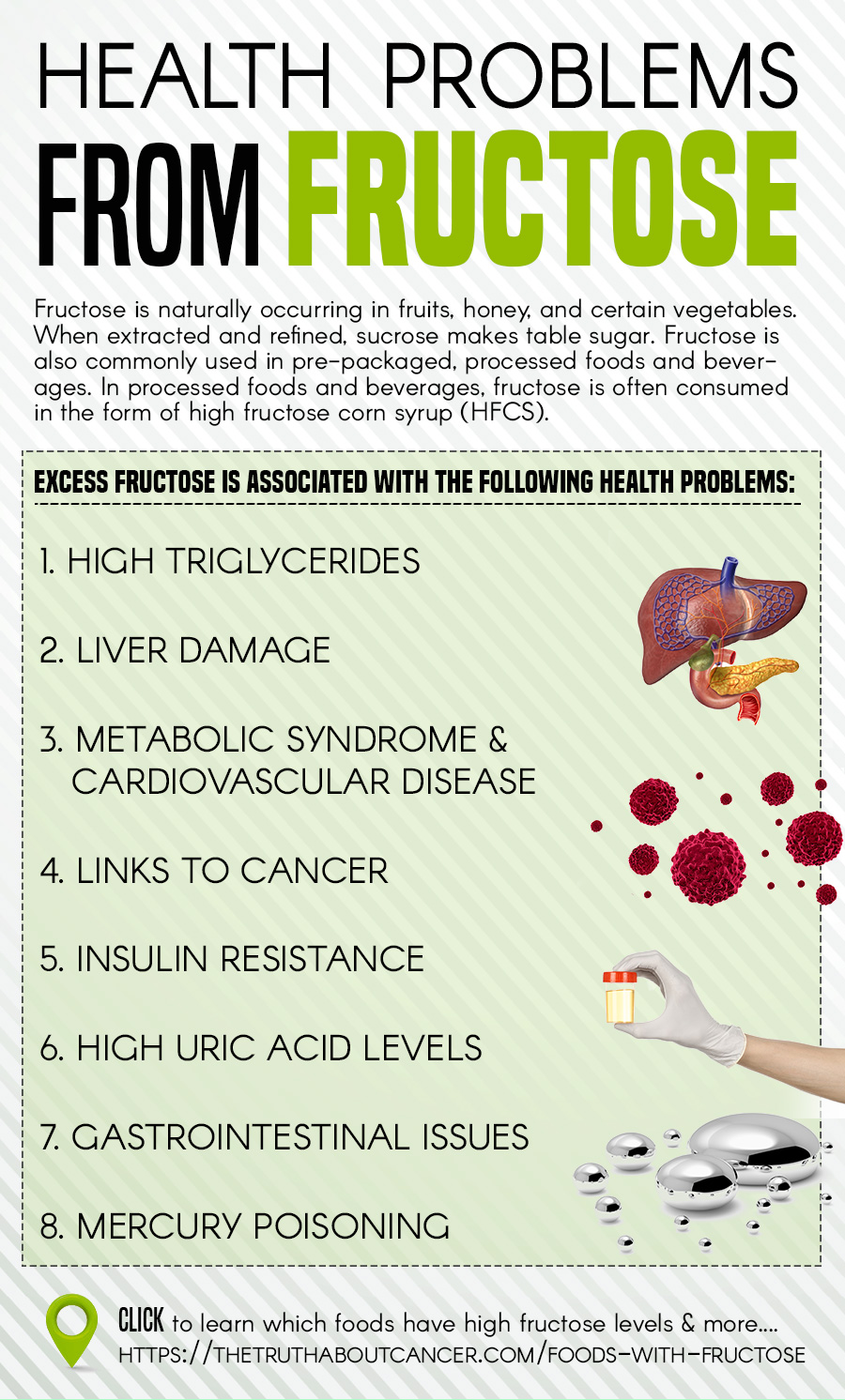Fructose is a simple sugar and is often called “fruit sugar.” It is a naturally occurring sugar found in fruits and vegetables. Fructose has come under a lot of scrutiny recently and you may have heard that consuming too much fructose isn’t good for you. This article will explain what fructose is, the potential problems with foods with fructose, and natural alternatives to fructose.
What is Fructose?
Fructose is a monosaccharide that is naturally occurring in fruits, honey, and certain vegetables. Fructose and glucose are the two sugar molecules (monosaccharides) that make up sucrose (a disaccharide).
Sucrose is the sugar that is found in sugarcane and sugar beets. When extracted and refined, sucrose makes table sugar. Fructose alone is nearly twice as sweet as sucrose. Because fructose is a simple sugar, it can be absorbed directly into the bloodstream.
Many foods containing fructose are otherwise healthy and nutritious, such as fruits and vegetables. Vegetables typically contain smaller amounts of fructose than fruits. When consumed in the form of fruits and vegetables, fructose is absorbed more slowly because of dietary fiber.
There are also many unhealthy foods that contain fructose. Fructose is commonly used in pre-packaged, processed foods and beverages. In processed foods and beverages, fructose is often consumed in the form of high fructose corn syrup (HFCS).
Other major sources of fructose include processed fruit juices, honey, and agave nectar. Although agave nectar is considered a low glycemic food, it is extremely dangerous due to the fructose content. Most agave nectar has a higher fructose content than any commercial sweetener, including high fructose corn syrup. Agave nectar is 70-90% fructose. In comparison, sugar is 50% fructose, honey is 52.6% fructose, and maple syrup is 49% fructose.
Excess fructose is associated with many health problems which are covered below. But first, it is important to know the amount of fructose in foods. Below is a list that will help you limit your daily fructose consumption.
The Amount of Fructose in Foods:
| FRUIT | Serving Size | Grams of Fructose |
| Limes | 1 medium | 0 |
| Lemons | 1 medium | 0.6 |
| Cranberries | 1 cup | 0.7 |
| Passion fruit | 1 medium | 0.9 |
| Prune | 1 medium | 1.2 |
| Apricot | 1 medium | 1.3 |
| Guava | 2 medium | 2.2 |
| Date (Deglet Noor style) | 1 medium | 2.6 |
| Cantaloupe | 1/8 of med. melon | 2.8 |
| Raspberries | 1 cup | 3.0 |
| Clementine | 1 medium | 3.4 |
| Kiwifruit | 1 medium | 3.4 |
| Blackberries | 1 cup | 3.5 |
| Star fruit | 1 medium | 3.6 |
| Cherries, sweet | 10 | 3.8 |
| Strawberries | 1 cup | 3.8 |
| Cherries, sour | 1 cup | 4.0 |
| Pineapple (3.5″ x .75″) | 1 slice | 4.0 |
| Grapefruit, pink or red | 1/2 medium | 4.3 |
| Tangerine/mandarin orange | 1 medium | 4.8 |
| Nectarine | 1 medium | 5.4 |
| Peach | 1 medium | 5.9 |
| Orange (navel) | 1 medium | 6.1 |
| Papaya | 1/2 medium | 6.3 |
| Honeydew | 1/8 of med. melon | 6.7 |
| Banana | 1 medium | 7.1 |
| Blueberries | 1 cup | 7.4 |
| Date (Medjool) | 1 medium | 7.7 |
| Apple (composite) | 1 medium | 9.5 |
| Persimmon | 1 medium | 10.6 |
| Watermelon | 1/16 med. melon | 11.3 |
| Pear | 1 medium | 11.8 |
| Raisins | 1/4 cup | 12.3 |
| Grapes, seedless (green or red) | 1 cup | 12.4 |
| Mango | 1/2 medium | 16.2 |
| Apricots, dried | 1 cup | 16.4 |
| Figs, dried | 1 cup | 23.0 |
Why You Need to Avoid High Fructose Corn Syrup
High fructose corn syrup (HFCS) is fructose that has been combined with corn syrup. It is chemically treated to increase the concentration and sweetness of the fructose.
Regular HFCS is 55% fructose and 45% glucose and has similar sweetness to sugar. Other forms of HFCS such as HFCS -90 are significantly sweeter than sugar.
High fructose corn syrup burst onto the commercial scene in the late 1950s and began to increase in usage the 1970s. This rapid growth occurred due to government subsidies for corn and sugar tariffs. This created an incentive to make sugar alternatives out of corn. Food and beverage manufacturers love HFCS because of its extremely low cost. Because it is a liquid and very sweet, HFCS is the preferred sweetener used in processed foods.
Despite recently coming under intense scrutiny, HFCS is still found in many processed, pre-packaged foods. These include soft drinks, juices, teas, breakfast cereals, baked goods, condiments, and other processed foods, including bread! If HFCS is an ingredient, you know that a product is low-quality, lacking nutrients, and full of artificial ingredients. A product with HFCS will not be whole, fresh, nutrient-rich food.
Health Problems Associated With Fructose Consumption
The average individual consumes over 40 grams of fructose daily with less than 13 grams coming from natural sources such as fruit and raw honey.
Many health experts believe that fructose is highly dangerous when consumed in excess of 25 grams per day. There are numerous health problems associated with excessive fructose consumption, including:
- Impact of Fructose on the Liver
Virtually every cell in the body can use glucose for energy. In contrast, fructose is primarily metabolized by the liver and creates stress on the liver detoxification system. There are many harmful effects from fructose metabolism in the liver including the formation of triglycerides, uric acid, and free radicals.
Excessive fructose consumption also contributes to the development of non-alcoholic fatty liver disease. Some researchers compare fructose metabolism to ethanol alcohol metabolism due to the toxic effects both have on the liver.
- Metabolic Syndrome and Cardiovascular Disease
Excessive fructose consumption appears to contribute to metabolic syndrome. Metabolic syndrome is a combination of at least three of the five following medical conditions: a large waistline, high triglycerides, low HDL levels (“good” cholesterol), high blood pressure, and high fasting glucose level.
Metabolic syndrome raises your risk for heart disease, stroke, and diabetes.
- Formation of Triglycerides
One way fructose consumption leads to metabolic syndrome is that fructose metabolism leads directly to triglyceride formation. Triglycerides are a form of fat found in the blood.
Elevated triglycerides lead to weight gain, obesity, type 2 diabetes, and heart disease. In 2009, Georgia State University researchers found that elevated triglycerides formed through fructose metabolism cause insulin resistance in the brain. This leads to decreased learning and memory, and accelerated brain tissue degeneration.
Another study linked the consumption of fructose-sweetened beverages with higher blood levels of LDL and triglycerides. Both LDL and triglycerides have been linked to increased risk of cardiovascular disease.
- Creation of Uric Acid
Uric acid is a normal waste product found in your blood. The metabolic processes involved in the breakdown of fructose can lead to a buildup of uric acid.
Uric acid is an inflammatory factor that increases free radical stress throughout the body. It depletes nitric oxide levels which leads to chronic tension and contraction in the arterial smooth muscle cells. These sorts of changes do not occur with normal starch or glucose consumption.
High uric acid levels are associated with gout, high blood pressure, kidney disease, and being overweight.
- Disrupts Hormone Messaging
Fructose affects the body’s hormonal system much differently than glucose and other forms of sugar. Fructose turns off the natural appetite control system by forming sugar molecules without stimulating the release of insulin.
Insulin is a hormone made by the pancreas that allows your body to use glucose for energy or to store glucose for future use. Insulin helps keep your blood sugar level from getting too high or too low.
Typically, as insulin rises in the body, it suppresses the hormone ghrelin (which initiates hunger) and stimulates leptin (which signals satiety). Fructose disrupts this natural hormone messaging system.
Without the proper hormonal signaling, an individual will be hungry and increase their food intake. The result is the production of more triglycerides which damage cells and lead to insulin resistance. Fructose severely impairs your body’s normal appetite control systems.
- Link to Cancer
There is an association between fructose consumption and intestinal cancers. It has also been shown that fructose consumption can negatively affect the outcome for breast cancer patients.
Another study showed that fructose levels were significantly higher in patients with pancreatic cancer than those with no pancreatic cancer.
- Gastrointestinal Issues
Fructose intolerance leads to gastrointestinal symptoms such abdominal pain, diarrhea, gas, and bloating. Limiting fructose consumption may help alleviate these symptoms.
- HFCS Contains Mercury
Two studies done in the U.S. found mercury in HFCS and in foods containing HFCS. In the first study, researchers found detectable levels of mercury in almost half of the samples of commercial HFCS.
In the second study, mercury was found in nearly a third of 55 popular brand-name food and beverage products where HFCS is the first- or second-highest labeled ingredient. Exposure to mercury, even in small amounts, may cause serious health problems.
Healthy Alternatives to Fructose
Now that we’ve covered some of the health problems associated with high fructose consumption, let’s look at healthy natural alternatives to fructose.
What makes a sweetener healthy? A healthy sweetener does not contain chemicals. It is made of only unambiguous, natural, whole-food sourced ingredients. A healthy sweetener should have minimal or no impact on blood sugar and insulin levels. A healthy sweetener also has nutritional value and provides health benefits, including promoting the gut microbiome (the collection of bacteria that thrive in your intestines).
There are two natural sweeteners that meet these criteria − stevia and monk fruit.
#1. Stevia:
- Stevia is a plant in the ragweed family that has been used for thousands of years. It is a zero-calorie sweetener and is 300 times sweeter than sugar.
- Stevia has no impact on blood sugar levels and has been found to have beneficial effects on blood sugar balance. It may even improve insulin signaling.
- Stevia is a diverse source of nutrients. It contains a broad range of polyphenols, carotenoids, chlorophyll compounds and amino acids.
- Stevia contains the compounds quercetin, apigenin, and kaempferol, all of which have been shown to reduce oxidative stress and potentially help control the development of cancer. Two compounds in stevia, stevioside and rebaudioside have been shown to have an anti-cancer effect.
- Stevia is also a potential immune-boosting agent with antimicrobial effects. It has even shown promise in combating Lyme disease.
#2. Monk Fruit:
- Monk fruit (also known as lo han or lo han guo) is a small, melon-like fruit that has been harvested and consumed for hundreds of years.
- Monk fruit has a positive impact on blood sugar levels. While less research exists on monk fruit as compared to stevia, preliminary studies show promise for improving insulin signaling by protecting pancreatic insulin-releasing cells from oxidative stress.
- Like stevia, monk fruit has zero calories. Monk fruit contains flavonoids, amino acids, polysaccharides, and triterpenes (which may have cancer-fighting potential).
- Monk fruit has many health benefits. Studies have found that mogroside V (one of the five compounds isolated from monk fruit) has the ability to inhibit tumor growth in pancreatic cancer. It may do so by interfering with the rapid dividing of cancer cells, thereby preventing angiogenesis (blood flow to the tumor), and even promoting cancer cell death.
- Monk fruit has almost identical immune-boosting and anti-microbial properties as stevia. Studies also show that monk fruit is an antioxidant and provides protection to the liver. All of these health benefits are the exact opposite of sugar’s detrimental effect on the body.
- When purchasing stevia or monk fruit, look for the purest form available or a whole-food extract. When available, purchase organic stevia or monk fruit, although a large majority of monk fruit is harvested from its natural habitat and meets organic standards even though it is not certified organic.
Don’t Use Artificial Sweeteners as a Replacement for Foods With Fructose
It is important that you do not replace foods with fructose with highly-refined artificial sweeteners like aspartame, sucralose, or saccharin (a.k.a. NutraSweet, Splenda, and Sweet-n-Low). These sweeteners should be avoided because they are toxic to the brain, destroy healthy gut bacteria, and may even cause weight gain by deregulating metabolism.
Be careful of claims that artificial sweeteners are “natural” when combined with healthier alternatives like stevia or monk fruit. These sweeteners are primarily chemical sweeteners with a touch of stevia or monk fruit. It is very important to read the labels of the products you buy.
Summary
Fructose is a naturally occurring sugar found in fruits and vegetables. Fructose is also found in high levels in High Fructose Corn Syrup and agave syrup.
Both fructose and HFCS contribute to a number of serious health issues including liver damage, metabolic syndrome, high triglycerides, high uric acid levels, insulin resistance, cancer, gastrointestinal issues, and mercury poisoning. Fructose should be limited to less than 25 grams a day. Healthy alternatives to fructose include stevia and monk fruit.
Please help bring more awareness to the dangers of consuming too much fructose by sharing this article with your friends and family below.
Article Summary
Fructose is a monosaccharide that is naturally occurring in fruits, honey, and certain vegetables. Fructose and glucose are the two sugar molecules that make up sucrose (table sugar).
Because fructose is a simple sugar, it can be absorbed directly into the bloodstream. When consumed in the form of fruits and vegetables, fructose is absorbed more slowly because of dietary fiber.
In processed foods and beverages, fructose is often consumed in the form of high fructose corn syrup (HFCS).
Avoid food products made with HFCS as it means it is low-quality, lacking nutrients, and full of artificial ingredients.
The average person consumes over 40 grams of fructose daily. Many health experts suggest limiting this to under 25 grams from natural sources only (e.g. fruit and raw honey).
Excessive fructose consumption is associated with numerous health problems.
A healthy sweetener should have minimal or no impact on blood sugar and insulin levels, and provide nutritional value including promoting gut health. The two best healthy sweeteners are stevia and monk fruit.




















does consuming fruit contribute to cancer growth
This is not a cut and dry question, nor is there a definitive answer. The answer, IMO, is that it could contribute to cancer growth if cancer is already present, and if it is being over-eaten, as opposed to an individual eating a balanced diet that includes fruit.
The caveat here is that generally speaking, fruit has Vit C, antioxidants, bioflavanoids, minerals, and fiber – these are all understood to improve immunity. Then there is the question of is the fruit organic or conventionally grown, as conventionally grown can have pesticides, herbicides, fungicides, etc. on the skin, and are you eating the skin of the fruit. Cancer is a metabolic issue with many variables, and whether or not fruit consumption contributes to cancer growth depends on a host of variables. .
Should I cut bread out of my diet? I found I’m fructose intolerant (causes extreme bloating, gas, diarrhea, acne). What else, besides fruit should I cut out of my diet to help prevent all of the symptoms?
I do not see monk fruit available in my local grocery stores in Ottawa, Canada. Where can I get it? Is monk fruit equivalent to papaya and mango?
I always knew some fructose could be bad, but I never knew that the effects could be so dangerous. I think we should all be careful in choosing the fruits we eat.
You can’t get the muscular strength you need without the aerobic endurance component. The next items on the health and fitness and nutrition and fitness components of the fitness and health and fitness factors list for adults are listed as follows:
This Article is Awesome. It’s help me a lot. Please keep up your good work. I always with you and Waiting for your new interesting articles.